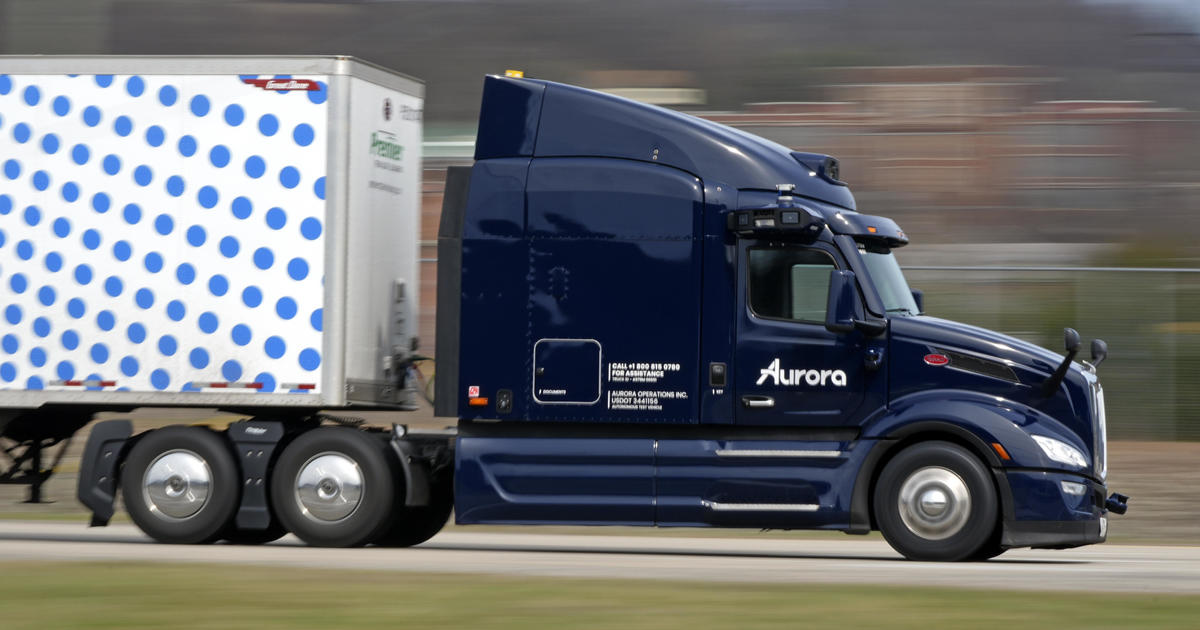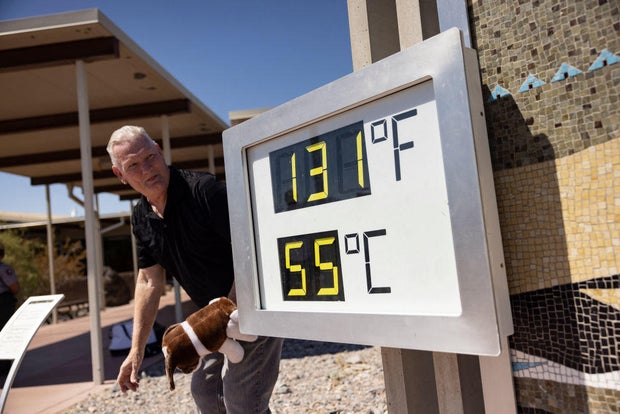CBS News
Self-driving tractor-trailers heading for U.S. roads

Pittsburgh — On a three-lane test track along the Monongahela River, an 18-wheel tractor-trailer rounded a curve. No one was on board.
A quarter-mile ahead, the truck’s sensors spotted a trash can blocking one lane and a tire in another. In less than a second, it signaled, moved into the unobstructed lane and rumbled past the obstacles.
The self-driving semi, outfitted with 25 laser, radar and camera sensors, is owned by Pittsburgh-based Aurora Innovation Inc. Late this year, Aurora plans to start hauling freight on Interstate 45 between the Dallas and Houston areas with 20 driverless trucks.
Gene J. Puskar / AP
Within three or four years, Aurora and its competitors expect to put thousands self-driving trucks on America’s public freeways. The goal is for the trucks, which can run nearly around the clock without breaks, to speed the flow of goods, accelerating delivery times.
The image of a fully loaded, 80,000-pound driverless truck on a super-highway at 65 mph or more may strike a note of terror. A January poll by AAA found that a majority of Americans – 66% – said they would fear riding in an autonomous vehicle.
But in less than nine months, trucks with Aurora’s systems will start carrying loads between terminals for FedEx, Uber Freight, Werner and others. Aurora and most rivals plan to start running freight routes in Texas, where snow and ice are generally rare.
For years, it seemed as though the initial venture for autonomous vehicles would be ride hailing in large cities. But General Motors’ Cruise robotaxi unit is struggling in the aftermath of a serious crash. And Alphabet’s Waymo faces opposition to expanding its autonomous ride service in California.
So self-driving trucks are poised to become the first computer-controlled vehicles deployed in widespread numbers on public roads.
Arguments for and against
However, safety advocates warn that with almost no federal regulation, it will be mainly up to the companies to decide when the semis are safe enough to operate without humans on board.
Aurora and other companies argue that years of testing show their trucks will be safer than human-driven ones. They note that the vehicles’ laser and radar sensors can “see” farther than human eyes. The trucks never tire, get distracted or become impaired by alcohol or drugs.
“We want to be out there with thousands or tens of thousands of trucks on the road,” said Chris Urmson, Aurora’s CEO. “And to do that, we have to be safe. It’s the only way that the public will accept it. Frankly, it’s the only way our customers will accept it.”
Phil Koopman, a Carnegie Mellon University professor who studies vehicle automation, agreed that self-driving trucks can theoretically be safer. But he cautioned that the vehicles’ computers inevitably will make errors. And just how the trucks fare on real roads, he said, depends on the quality of their safety engineering.
With billions of dollars in investments at stake, Koopman said, he wonders how the companies will balance safety decisions.
“Everything I see indicates they’re trying to do the right thing,” he said. “But the devil is in the details.”
On the test track, reporters saw Aurora’s semis avoid simulations of road obstacles, including pedestrians, a blown tire, even a horse. The trucks spotted obstacles more than a quarter-mile away and avoided them.
But they were running at only 35 mph in a controlled environment. (The trucks are being tested with human safety drivers on Texas freeways, at higher speeds.)
Since 2021, Aurora trucks have autonomously hauled freight over 1 million miles on public highways with human safety drivers on board. There have been only three crashes, Urmson said, all caused by mistakes by human drivers in other vehicles.
A federal database started in June 2021 shows at least 13 crashes with other vehicles involving autonomous semis, including three involving Aurora. In all cases, the crashes were caused by other vehicles.
Bottom lines
Last month, Urmson said the publicly held company expects to turn a profit by late 2027 or early 2028. To do so, Aurora must deploy thousands of trucks, hauling freight and collecting a per-mile charge from customers.
Aurora, Urmson said, won’t compromise safety, even if doing so might delay turning a profit.
“If we put a vehicle on the road that isn’t sufficiently safe – that we aren’t confident in the safety of – then it kills everything else,” he said.
The company’s competitors – Plus.ai, Gatik, Kodiak Robotics and others – also plan soon to put driverless trucks on the roads hauling freight for customers. Gatik expects it this year or next; the others haven’t set timetables.
Don Burnette, CEO of Kodiak, said freeways are a better environment for autonomous vehicles than cities where ride-hailing robotaxis have been running. There are fewer pedestrians and fewer unexpected things happen.
“Accident waiting to happen”
At a Buc-ee’s mega convenience store along I-45 south of Dallas, the prospect of driverless semis struck a note of fear.
“It sounds like a disaster waiting to happen,” said Kent Franz, a high school basketball coach in Chandler, Oklahoma. “I’ve heard of the driverless cars – Tesla, what have you – and the accidents they’ve been having. Eighteen-wheelers? Something that heavy, relying on technology that has proven it can be faulty? Doesn’t sound very comfortable to me.”
No federal regulations specifically cover autonomous vehicles, Koopman of Carnegie Mellon noted. And most states have none. As a result, he said, the public must trust the companies.
Federal agencies lack authority to stop autonomous vehicles from going on the roads. If something goes wrong, though, they can require recalls or order trucks out of service.
The companies say the driverless semis can help address a truck driver shortage, estimated by the trucking industry to be 64,000 drivers. Yet there also are worries that autonomous trucks eventually will supplant human drivers and cost them their livelihoods.
Aurora’s Urmson said he thinks driverless semis will complement the work already done by human drivers.
“If you’re driving a truck today,” he said, “my expectation is you’re going to be able to retire driving a truck.”
CBS News
7/7/2024: Targeting Americans; Kevin Hart

Watch CBS News
Be the first to know
Get browser notifications for breaking news, live events, and exclusive reporting.
CBS News
7/7/2024: 3D Printing; Your Chatbot Will See You Now

Watch CBS News
Be the first to know
Get browser notifications for breaking news, live events, and exclusive reporting.
CBS News
At least 1 dead, records shattered as heat wave continues throughout U.S.

A long-running heat wave that has already shattered previous records across the U.S. persisted on Sunday, baking parts of the West with dangerous temperatures that caused the death of a motorcyclist in Death Valley and held the East in its hot and humid grip.
An excessive heat warning — the National Weather Service’s highest alert — was in effect for about 36 million people, or about 10% of the population, said NWS meteorologist Bryan Jackson. Dozens of locations in the West and Pacific Northwest tied or broke previous heat records.
Many areas in Northern California surpassed 110 degrees, with the city of Redding topping out at a record 119. Phoenix set a new daily record Sunday for the warmest low temperature: it never got below 92 F.
A high temperature of 128 F was recorded Saturday and Sunday at Death Valley National Park in eastern California, where a visitor died Saturday from heat exposure and another person was hospitalized, officials said.
ETIENNE LAURENT/AFP via Getty Images
The two visitors were part of a group of six motorcyclists riding through the Badwater Basin area amid scorching weather, the park said in a statement.
The person who died was not identified. The other motorcyclist was transported to a Las Vegas hospital for “severe heat illness,” the statement said. Due to the high temperatures, emergency medical helicopters were unable to respond, as the aircraft cannot generally fly safely over 120 F, officials said.
The other four members of the party were treated at the scene.
“While this is a very exciting time to experience potential world record-setting temperatures in Death Valley, we encourage visitors to choose their activities carefully, avoiding prolonged periods of time outside of an air-conditioned vehicle or building when temperatures are this high,” said park Superintendent Mike Reynolds.
Officials warned that heat illness and injury are cumulative and can build over the course of a day or days.
“Besides not being able to cool down while riding due to high ambient air temperatures, experiencing Death Valley by motorcycle when it is this hot is further challenged by the necessary heavy safety gear worn to reduce injuries during an accident,” the park statement said.
ETIENNE LAURENT/AFP via Getty Images
The soaring temperatures didn’t faze Chris Kinsel, a Death Valley visitor who said it was “like Christmas day for me” to be there on a record-breaking day. Kinsel said he and his wife typically come to the park during the winter, when it’s still plenty warm — but that’s nothing compared with being at one of the hottest places on Earth in July.
“Death Valley during the summer has always been a bucket list thing for me. For most of my life, I’ve wanted to come out here in summertime,” said Kinsel, who was visiting Death Valley’s Badwater Basin area from Las Vegas.
Kinsel said he planned to go to the park’s visitor center to have his photo taken next to the digital sign displaying the current temperature.
Across the desert in Nevada, Natasha Ivory took four of her eight children to a water park in Mount Charleston, outside Las Vegas, which on Sunday set a record high of 120 F.
“They’re having a ball,” Ivory told Fox5 Vegas said. “I’m going to get wet too. It’s too hot not to.”
Jill Workman Anderson also was at Mount Charleston, taking her dog for a short hike and enjoying the view.
“We can look out and see the desert,” she said. “It was also 30 degrees cooler than northwest Las Vegas, where we live.”
ROBYN BECK/AFP via Getty Images
Triple-digit temperatures were common across Oregon, where several records were toppled — including in Salem, where on Sunday it hit 103 F, topping the 99 F mark set in 1960. On the more humid East Coast, temperatures above 100 degrees were widespread, though no excessive heat advisories were in effect for Sunday.
“Drink plenty of fluids, stay in an air-conditioned room, stay out of the sun, and check up on relatives and neighbors,” read a weather service advisory for the Baltimore area. “Young children and pets should never be left unattended in vehicles under any circumstances.”
Rare heat advisories were extended even into higher elevations including around Lake Tahoe, on the border of California and Nevada, with the weather service in Reno, Nevada, warning of “major heat risk impacts, even in the mountains.”
“How hot are we talking? Well, high temperatures across (western Nevada and northeastern California) won’t get below 100 degrees until next weekend,” the service posted online. “And unfortunately, there won’t be much relief overnight either.”
More extreme highs are in the near forecast, including possibly 130 F around midweek at Furnace Creek, California, in Death Valley. The hottest temperature ever officially recorded on Earth was 134 F in July 1913 in Death Valley, though some experts dispute that measurement and say the real record was 130 F, recorded there in July 2021.
Tracy Housley, a native of Manchester, England, said she decided to drive from her hotel in Las Vegas to Death Valley after hearing on the radio that temperatures could approach record levels.
“We just thought, let’s be there for that,” Housley said Sunday. “Let’s go for the experience.”
In Arizona’s Maricopa County, which encompasses Phoenix, there have been at least 13 confirmed heat-related deaths this year, along with more than 160 other deaths suspected of being related to heat that are still under investigation, according to a recent report.
That does not include the death of a 10-year-old boy last week in Phoenix who suffered a “heat-related medical event” while hiking with family at South Mountain Park and Preserve, according to police.
In California, crews worked in sweltering conditions to battle a series of wildfires across the state.
In Santa Barbara County, northwest of Los Angeles, the growing Lake Fire had scorched more than 25 square miles of dry grass, brush and timber after breaking out Friday. There was no containment by Sunday. The blaze was burning through mostly uninhabited wildland, but some rural homes were under evacuation orders.







